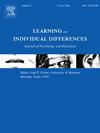学习作为记忆;通过不同样本的小学生的记忆整合对自创知识的保留的检验
IF 9
1区 心理学
Q1 PSYCHOLOGY, EDUCATIONAL
引用次数: 0
摘要
孩子们通过直接的教学来学习,但也通过生产过程来学习,这些过程导致了自己获得的知识,而不是直接教授的。例如,如果一个孩子知道液体在加热时会膨胀,那么他们就会知道温度计含有液体,他们就可以得出新的知识,温度计之所以工作是因为里面的液体在加热时会膨胀。先前的研究表明,儿童在课堂上通过记忆整合进行自我推导,而表现可以预测学习成绩。然而,对生产过程中产品的保留情况的调查却很少。考虑到记忆对于长期知识构建的重要性,我们通过两项研究考察了小学生通过记忆整合对自我推导产品的保留情况。研究1通过课堂整合考察了自推导产物的保留情况。在研究2中,我们用一个新的样本和与课程一致的刺激重复了研究1 (2a),并检查了编码时的图形是否支持记忆(2b)。在这两项研究中,我们研究了记忆力是否能解释学习成绩的个体差异。结果表明,儿童通过生产过程获得的知识至少保留了一周。此外,通过使用图形支持编码有助于记忆。我们还发现了对个人学习成绩差异的保留会计的支持。教育相关性陈述孩子们通过直接指导学习,但也通过整合课程中的知识来学习。例如,如果一个孩子知道液体在加热时会膨胀,那么他们就会知道温度计含有液体,他们就可以得出新的知识,温度计之所以工作是因为里面的液体在加热时会膨胀。个人自我获取知识的能力预示着学习成绩。在这项研究中,我们考察了延迟一周后自我衍生知识的保留情况。在研究1中,我们发现保留是困难的。在一周的延迟中,儿童的记忆力明显下降。在研究2中,我们检查了与课程一致的事实的整合和记忆,并检查了在事实展示中添加图形是否有助于记忆。我们再次发现了留存的证据,加上图形的事实展示导致了表现的提高。在这两项研究中,知识的自我推导和知识的保留预测了阅读和数学学业成绩的个体差异。本文章由计算机程序翻译,如有差异,请以英文原文为准。
Learning as retention; an examination of retention of self-derived knowledge through memory integration in a diverse sample of elementary students
Children learn through direct tuition, but also through productive processes that result in self-derived knowledge that was not directly taught. For example, if a child learns that liquid expands when heated, then they learn that thermometers contain liquid, they can derive the new knowledge that thermometers work because the liquid inside expands when heated. Previous work has shown that children engage in self-derivation through memory integration in their classrooms and performance predicts academic performance. However, there has been little examination of the retention of the products of productive processes. Given the importance of retention for long-term knowledge building, we examined the retention of the products of self-derivation through memory integration in elementary students across two studies. Study 1 examined retention of the products of self-derivation through integration in classrooms. In Study 2, we replicated Study 1 with a new sample and stimuli aligned to the curriculum (2a) and examined whether graphics at encoding support retention (2b). Across both studies, we examined whether retention performance accounts for individual differences in academic performance. The results indicate that children do retain knowledge gained through productive processes for at least one week. Further, support at encoding through the use of graphics facilitates retention. We also found support for retention accounting for individual differences in academic performance.
Educational relevance statement
Children learn through direct instruction but also through knowledge they generate themselves by integrating facts across lessons. For example, if a child learns that liquid expands when heated, then they learn that thermometers contain liquid, they can derive the new knowledge that thermometers work because the liquid inside expands when heated. Individual ability to self-derive knowledge predicts academic performance. In this research, we examined retention of the self-derived knowledge after a one-week delay. In Study 1, we found that retention is difficult. Children had significant loss in memory over the one-week delay. In Study 2, we examined integration and retention of curriculum aligned facts and examined whether adding a graphic to the fact presentation supported retention. We again found evidence for retention and the addition of a graphic at fact presentation resulted in an increase in performance. Across both studies, self-derivation of knowledge and retention of that knowledge predicted individual differences in academic performance in both reading and math.
求助全文
通过发布文献求助,成功后即可免费获取论文全文。
去求助
来源期刊

Learning and Individual Differences
PSYCHOLOGY, EDUCATIONAL-
CiteScore
6.60
自引率
2.80%
发文量
86
期刊介绍:
Learning and Individual Differences is a research journal devoted to publishing articles of individual differences as they relate to learning within an educational context. The Journal focuses on original empirical studies of high theoretical and methodological rigor that that make a substantial scientific contribution. Learning and Individual Differences publishes original research. Manuscripts should be no longer than 7500 words of primary text (not including tables, figures, references).
 求助内容:
求助内容: 应助结果提醒方式:
应助结果提醒方式:


